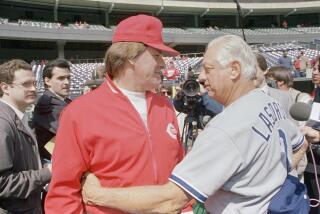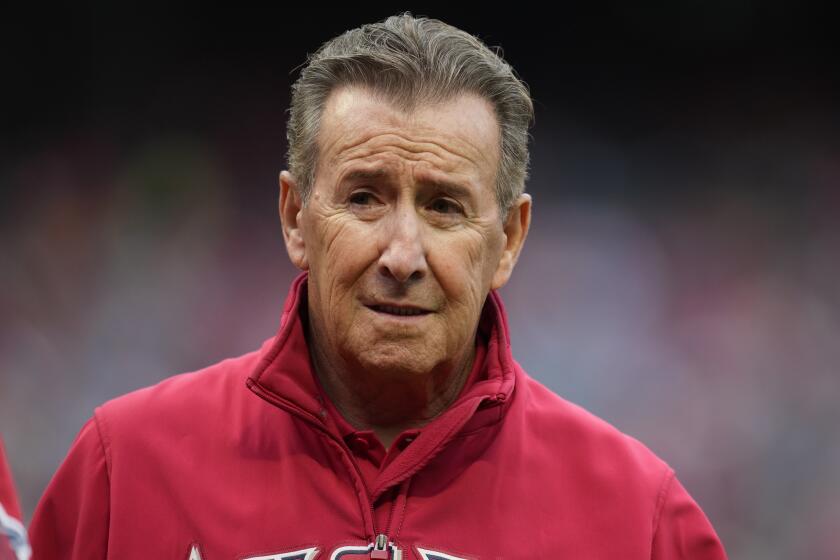At Ease, at Last
It has been 40 years, but he still remembers the pitch. The second pitch. The final pitch.
It was late September 1963. It was a low inside fastball. He lined it down the left-field line. He sprinted to second base. The crowd roared.
Inside a crisp new Dodger uniform, Roy Gleason’s heart leaped.
He was 20, and after his first major league plate appearance, he was batting 1.000.
“I thought I was going to be a superstar,” he remembered, and how was he to know?
How does anyone know that his first chance is his last? How can anyone so young imagine a future so unimaginable that, instead of running into the dugout embrace of his teammates, he should have stayed on second base forever?
It has been 40 years, and Roy Gleason is still batting 1.000.
Before he was sent to home plate again in the majors, he was plucked from spring training and shipped to Vietnam. His baseball skills were damaged in jungle fighting. His World Series ring disappeared at a base camp in the bush.
The outfielder returned to the Dodgers long enough for them to realize he would never be the same. They sold him to the Angels, who quickly shipped him to the Mexican League, his last stop before an auto accident ended his pro career with that lone plate appearance.
If only Roy Gleason could have stayed on second base forever ...
He retired in Orange County, in obscurity, working as a furniture mover, a bartender, a car salesman.
He is the only Los Angeles Dodger to have earned a Purple Heart, yet when the team needed a hero for an old-timers’ game or autograph session, nobody called.
Records indicate he was the only player with major league experience who fought in Vietnam, yet when the team needed somebody to throw out a pitch on Memorial Day, nobody remembered.
Disconnected from the organization, tethered to his remorse, Roy Gleason finally stopped going to Dodger Stadium in 1984.
“I just couldn’t bear it,” he said. “I thought I was through with baseball forever.”
Then, an innocent phone call, an inquiring historian, and a giant embracing tradition.
A couple of years ago, Wally Wasinack, an Orange County businessman, bought a car from Gleason. The salesman’s story was so compelling, Wasinack decided to write a book about him.
This summer, Wasinack phoned the Dodgers in search of records and photos.
“I had no idea what they would say, I didn’t know whether they had even heard of him,” Wasinack said.
Answering the phone, Dodger historian Mark Langill had indeed heard of Gleason but knew little else. About five minutes into the conversation, his jaw dropped.
“I knew the name, I knew the one-for-one, but to hear the rest of it, I was fascinated,” he said. “That this story was out there for 40 years and nobody had written about it was unbelievable.”
Langill invited Gleason to Dodger Stadium. Gleason hesitantly accepted. Once there, he reluctantly shared.
“He was so humble, so genuine,” Langill said. “It was like pulling teeth to get him to talk about his accomplishments.”
Then, slowly, amazingly, walking from the clubhouse to the upper press dining room, Gleason realized something about this team he had tried to forget.
They had never forgotten him.
Tom Lasorda spotted him in a hallway and reminded him of his big signing bonus. Bruce Froemming, an umpire, recognized him immediately and remembered a minor league rhubarb. Aging scouts stood up from their dinners to pat his back and tell him stories.
Their visit eventually ended up in the tunnel behind the Dugout Club, next to a wall bearing most of the names from the Dodgers’ all-time roster.
Gleason scanned the montage and said, “I’m sure I’m not up here.”
Langill stood behind him thinking, “Please be up there. Please be up there.”
After a few minutes, they found it, above Roy Campanella, below Delino DeShields.
Roy Gleason
“I didn’t really feel like I played enough to warrant being called a major leaguer,” he said.
He touched the wall gently, with a finger that has been numb since he took shrapnel in Vietnam. His eyes glazed. The truth hit.
Once a Dodger, always a Dodger, even if only momentarily a Dodger.
He had never left second base after all.
Sgt. Gleason looked at Langill and shook his head.
“I’m glad I’m on this wall, instead of the other wall,” he said.
*
As a kid at Garden Grove High, he was so talented, he would pitch batting practice to the big leaguers at the Coliseum.
As a prospect, he was so valued, Ted Williams recruited him personally for the Boston Red Sox.
But Roy Gleason wanted to be only a Dodger, so he signed quickly, and was promoted quickly from the lower minor leagues, getting a September call-up to the big league team after only his second full minor league season.
Once here in 1963, he realized he was faster than everyone but Willie Davis. He was used seven times as a pinch-runner, once as a batter, and everything was possible.
“I knew they had a great team, and I knew it might be a while before I got back,” Gleason said. “But I knew I could eventually play here.”
He was not on the World Series roster, spending that time in the Arizona Instructional League with the other top prospects. He then spent the next three years moving up the ladder, waiting for an opening on a major league team featuring an outfield that included, at various times, Willie Davis, Tommy Davis, Frank Howard and Lou Johnson.
In 1967, after Sandy Koufax retired and Maury Wills was traded, the Dodgers were finally starting a rebuilding phase that would include still-young Gleason.
He arrived at Dodgertown that spring, thinking this would be his chance.
Then he received a letter from the government saying he had been drafted.
“I went from the highest of highs, to the absolute low,” he said.
Most baseball players avoided Vietnam because their teams arranged for them to serve in the National Guard. But because Gleason was the sole support of his mother and two sisters, he was already ineligible. Or so he thought.
At his induction ceremony, he was the only recruit in the room who would not recite the pledge or take that traditional one step forward.
“I told the officers that they had made a mistake, that I needed to be home to support my family,” he said. “They told me to put in for a hardship discharge.”
It took more than a year for that paperwork to be processed. By then, he had already been to hell and back.
While his Dodger buddies were throwing fastballs, Gleason was throwing hand grenades in the jungle during an eight-month stint there.
“That was one way my baseball abilities helped,” he said. “They used to say that I didn’t need to shoot out of a cannon, that I already had one.”
While Don Drysdale was fashioning his scoreless-innings streak, Gleason could only read about it in letters from former Dodger executive Buzzie Bavasi and members of the Dodger fan club.
“It was so hard, sitting in the jungle and thinking about what could have been,” he said.
And instead of competing for rookie-of-the-year honors, Gleason was being named soldier of the month. In a photo of the ceremony, he can be seen wearing his World Series ring with his fatigues.
But as his reward, he was made a point man on dangerous missions, even at 6 feet 4.
“I walked small,” he said. “And they were running out of guys.”
On one such mission, on July 24, 1968, a shell exploded out of a tree above him, tearing a hole in his left calf and left wrist. He kept fighting even though he couldn’t walk, and blood was spurting from both wounds.
He was whisked from the battlefield in a chopper, his foot locker with his World Series ring left behind.
Less than a year later, honorably discharged, he was back in spring training, still hopeful at 26, still trying to make the Dodgers, even as team doctors were removing bits of bulging shrapnel from his leg.
His injured left leg affected his speed. His numb finger affected his batting grip. And then the freak accident -- a buddy drove a car over a cliff, with Gleason in the car -- tore his right shoulder and finished his career.
“He could have been a big hero in this town, but it was the wrong time for him,” Bavasi said. “The Army took a lot out of him.”
Gleason’s family had lost the house while he was at war, so he wasn’t rich.
He’d had only one major league at-bat, so he wasn’t famous.
After bouncing around at various odd jobs, Gleason, with the help of former Dodger Jimmy Campanis, became a car salesman at a Honda dealership, where he worked until recently.
He married twice, raised two boys, lived a quiet life that somehow felt like an unfulfilled life.
“I think he originally thought his life was a waste,” Wasinack said.
Saturday night at Dodger Stadium, he will again be reminded of his error.
Before the game against the San Francisco Giants, Roy Gleason will throw out the first pitch.
He’s a senior citizen now, gray hair, glasses, a slight limp.
But for one moment, he will be 20 again. For one moment, he will hear the cheers he was denied, bask in the glow that was stolen away.
For the first time, his family will see him in his natural surroundings.
For the first time, Dodger fans can give him a proper greeting.
Ladies and gentlemen, introducing the Dodgers’ all-time leading hitter, batting 1.000 forever, the great Roy Gleason.
*
Bill Plaschke can be reached at [email protected].
More to Read
Go beyond the scoreboard
Get the latest on L.A.'s teams in the daily Sports Report newsletter.
You may occasionally receive promotional content from the Los Angeles Times.







